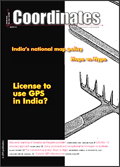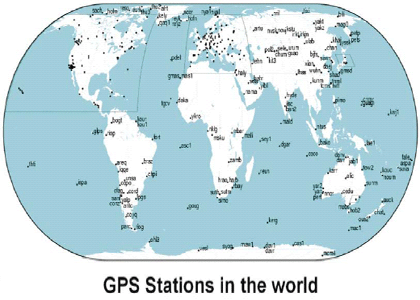July 2005
IGARSS 2005
25 – 29 July 2005 Seoul, Korea
reg@igarss05.org
http://www.igarss05.org
25th Annual ESRI International …

Was early warning of Sumatra earthquake possible? SHUNJI MURAI AND HARUMI ARAKI
GAGAN – A visionary approach ARJUN SINGH
Using positional and navigational technologies in Australia ALLAN K BARNES
The national map policy: Hope vs Hype MUNEENDRA KUMAR, JG KRISHNAYYA, AJAY LABAKARE AND NK AGRAWAL
Scalable GPS infrastructure NATHAN PUGH
NoCoordinates is a new section, where readers questions …

IV MURALI KRISHNA Professor and Head, Centre for Spatial Information Technology, Jawaharlal Nehru Technological University, Hyderabad
iyyanki@icorg.org
Geodesy is science of the measurement and mapping of the earth’s surface. Satellite Geodesy in an orderly intensive manner started with the launch of the first artificial satellite SPUTNIK in October 1957. By the year 1964, many basic geodetic problems …
We were taken aback.
We were taken aback when we were told by none other than the Wireless Advisor to Government …

As the designers and builders of infrastructure; surveyors, engineers and construction contractors know well the benefits gained from a strong infrastructure. Whether transportation, utilities or communication systems, infrastructure constitutes a society’s basic structure, the foundation upon which the growth of a community, state or entire nation depends.

While digital techniques were introduced to map production in the 1970’s, the driver for utilising digital tools to manage this wide range of activities was the land administration functions of the six states and two territories. Developed in concert by the legal and surveying professions, these state and territory based land administrations functions led to digital land valuation systems as early as 1968 in South Australia. Building upon such initiatives; government guaranteed computerised land registration and automated valuation systems have been built.

In order to provide seamless navigation to the world aviation community by airport service providers, the International Civil Aviation Organization (ICAO) has adopted a new strategy on the implementation of Future Air Navigation System (FANS) and use of non-visual aids for approach, and landing. The solution for the above requirements is Global Navigation Satellite System (GNSS). A stand alone GPS fails to provide the required navigation accuracy for all phases of the flight. Therefore, to achieve the required navigation accuracy, the core constellation i.e. GPS, GLONASS, and Galileo (under planning stage) needs augmentations to fulfill the GNSS, particularly in satellite-based augmentations such as WAAS (USA), EGNOS (Europe), MSAS (Japan), GRAS (Australia) and GAGAN (India). It also includes ICAO’s acceptance of an offer to make the Global Orbiting Navigation Satellites System (GLONASS) available for use by civil aviation. The ICAO Council had earlier accepted a similar offer concerning the GPS. These three satellite constellations (GPS / GLONASS / Galileo) are the key components of the GNSS. This article describes briefly, the different systems including GAGAN (India) and the status of GNSS.

Since Japan is an earthquake prone country with a lot of volcanoes and active faults, Geographic Survey Institute (GSI), the Government of Japan has constructed about 1,200 GPS Fixed Stations called “electronic control points” all over Japan. Since 2003, GSI released GPS data to public through web site. The authors have already checked and confirmed the evidence of early warning for the past big earthquakes such as Tokachi Earthquake (M8.0: 2003.9.26) and Nigata Chu-etsu Earthquake (M6.8: 2004.10.23) which occurred in Hokkaido, north of Japan and middle of Japan respectively. International GPS Service (IGS) provides world wide GPS data at GPS stations located at 10 stations near Indonesia and other Asian regions.







 (5.00 out of 5)
(5.00 out of 5)